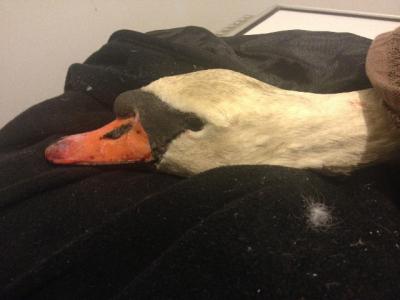Swan a Victim of Hit-and-Run

An adult mute swan that was hit by a car near Town Pond on Monday suffered injuries too serious to repair and was euthanized shortly after at Dr. Jonathan Turetsky’s veterinary office in East Hampton.
The swan, one of a pair often seen at the pond, was hit on James Lane around noon by an unknown driver. East Hampton Village police were called, and several people called Dr. Turetsky’s office, which contacted the Evelyn Alexander Wildlife Rescue Center in Hampton Bays. As Jane Gill, a transport volunteer with the center, arrived on the scene to take the injured bird to the veterinarian’s office, its mate watched from a distance, uttering a shrill call.
“Unfortunately, it’s a pretty sad story,” Dr. Turetsky said on Monday afternoon. “One of the swan’s wings was badly shattered; it had a compound fracture above the elbow,” he said. The wing could not be repaired, and amputation, he said, was not an option, as swans do very poorly in the wild after such surgery. It also had “nerve damage to its right foot and pretty significant head trauma,” he said.
In consultation with the wildlife rescue center, it was decided that euthanizing it was the most humane option, the veterinarian said.
The dead swan’s mate will likely remain on his or her own for now. “They do mourn for quite a while, but they will eventually take another mate,” Ginnie Frati, the executive director of the wildlife rescue center, said Monday. He or she — Dr. Turetsky was unsure of the sex of the dead swan — “probably won’t take a mate this year,” Ms. Frati said. But the remaining swan could make its home elsewhere and a new swan pair may take the place of that pair on the pond, as has often happened over the years.
Dr. Turetsky said his office sees injured wild animals almost every day, and he often performs surgery on those animals when their injuries are treatable. “We had a deer in yesterday that had two badly fractured back legs,” he said Monday. It had apparently suffered with the injuries for several days. It was pregnant, he said, but attempts to save the doe and deliver the fawns were not successful.
Had it been possible to treat the deer or the swan, each would have been taken to the wildlife center to be cared for in its animal hospital, and then rehabilitated and released back into the wild, Ms. Frati said.
Interestingly, both species have been targeted for culling by various governmental agencies this year. A program overseen by the Long Island Farm Bureau and the United States Department of Agriculture would have placed trained U.S.D.A. sharpshooters in several municipalities, including East Hampton Town and Village, in an effort to reduce deer populations. Opponents of that program won a temporary restraining order to stop it in State Supreme Court, and the participating towns and villages on the South Fork called off the culls.
Where mute swans are concerned, a controversial management plan put forward by the New York State Department of Environmental Conservation calls for the eradication of the species in the state by 2025. Had that plan been in place, the wildlife rescue center would have been prohibited from releasing a rehabilitated mute swan back into the wild. Technically, the species is an invasive one, and, according to the D.E.C., the state’s mute swans, which number 2,200, displace native wildlife, destroy aquatic vegetation, degrade water quality, pose a hazard to aircraft, and are aggressive toward people.
News of the D.E.C.’s grim plans for mute swans prompted a number of citizens’ efforts, including a petition drive, to oppose the elimination of the species.
The deadline for comments on this plan was Friday, but some state lawmakers are challenging the agency to prove that the swan population is as detrimental as it claims.
Assemblyman Fred W. Thiele Jr. is among the sponsors of legislation that would impose a two-year moratorium on declaring the mute swan a “prohibited invasive species” and eliminating them from the wild through trapping and hunting, or destroying their eggs.
According to a press release issued by Mr. Thiele two weeks ago, “Wildlife experts, rehabilitators, and environmentalists do not unanimously agree that exterminating the mute swan population is justified. In addition, there is debate amongst such experts about whether the planned eradication of the mute swan population is even minimally beneficial to the ecosystem or to our environment.”
“My office has not received one report in all my years in office that the mute swan is a nuisance or an environmental problem,” Mr. Thiele said in the release.
If the plan had been in place this week and the Town Pond swan could have been saved, “We would only have been able to release it to a swan sanctuary,” Ms. Frati said. However, she is not aware of any such sanctuaries.
The wildlife center, too, has weighed in against the D.E.C.’s proposed swan management plan, Ms. Frati said. “We can’t ethically euthanize a healthy animal,” she said. “If this passes, they would want us to put them to sleep.”
With Reporting by Joanne Pilgrim
